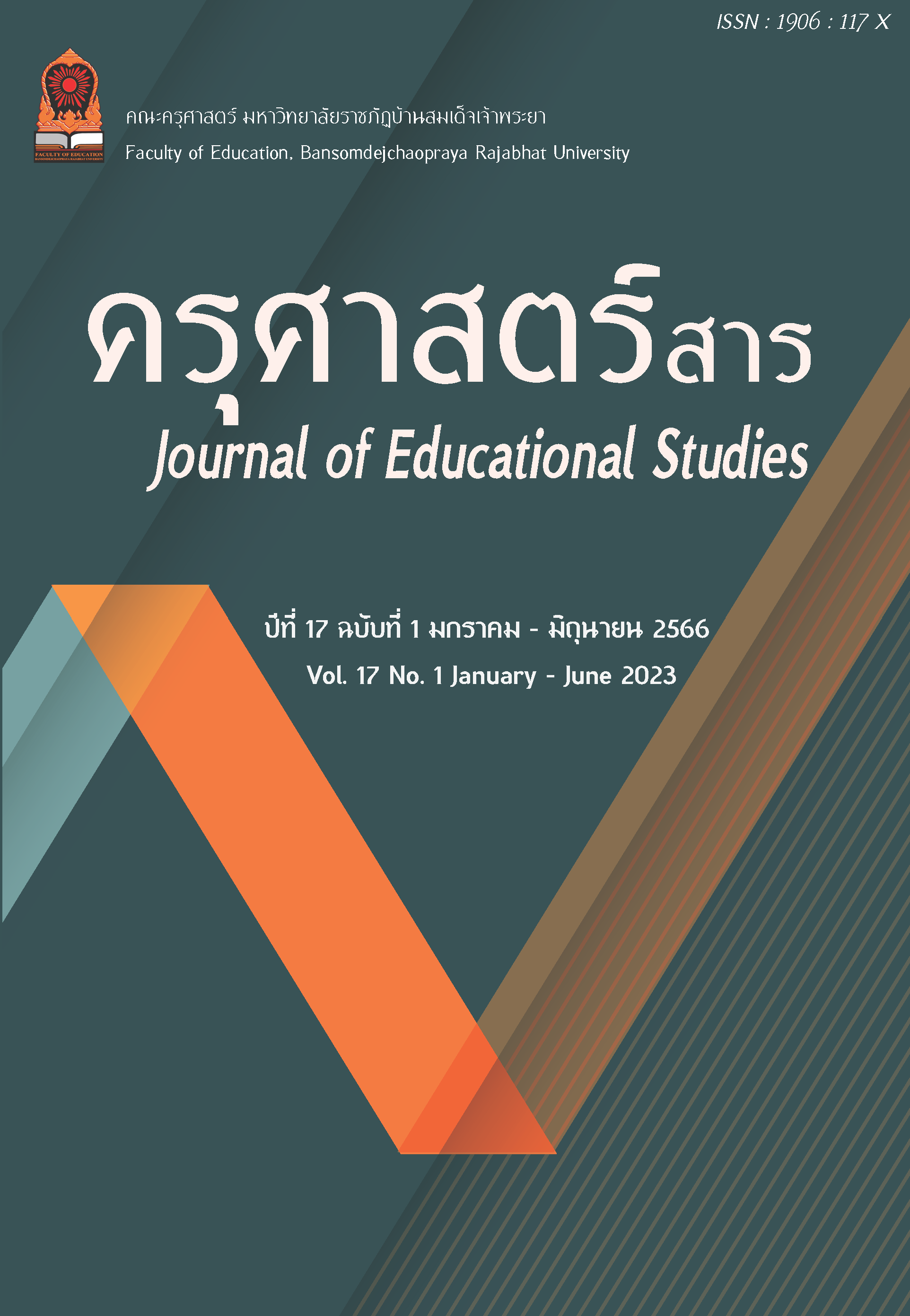Enhancing Student Competencies Using the Concept of Active Learning
Abstract
This article aims to present an understanding of the concept of active learning management and the active learning management method that enhances student competencies. Active learning is a student - centered learning management which creates experience with active action involves intellectual, physical, emotional and social according to the aptitude and ability of the learners. The active learning management method aims to provide learners with the necessary competencies for their studies, work performance, problems solving in various situations and living a normal life as a good citizen. This article presents the definitions of active learning management, philosophies, theories and the concepts of active learning management, competency-based learning, and competency-based active learning management.
Downloads
References
บังอร เสรีรัตน์. (2565). ครูกับการพัฒนาสมรรถนะผู้เรียน. วารสารศิลปากรศึกษาศาสตร์วิจัย, 14(1), 1-11.
พิมพันธ์ เดชะคุปต์ และพเยาว์ ยินดีสุข. (2561). การเรียนรู้เชิงรุกแบบรวมพลังกับ PLC เพื่อการพัฒนา. กรุงเทพฯ: โรงพิมพ์แห่งจุฬาลงกรณ์มหาวิทยาลัย.
มนสิช สิทธิสมบูรณ์. (2565). กลยุทธ์การจัดการเรียนรู้เชิงรุก. พระนครศรีอยุธยา: โรงพิมพ์มหาจุฬาลงกรณ์ราชวิทยาลัย.
สาริตา บัวเขียว. (2559). Scaffolding ช่วยเสริมสร้างการพัฒนาการเรียนรู้อย่างไร. วารสารมนุษยสังคม
ปริทัศน์, 18(1), 1-15.
สำนักงานเลขาธิการสภาการศึกษา. (2562). แนวทางการพัฒนาสมรรถนะผู้เรียนระดับการศึกษาขั้นพื้นฐาน. นนทบุรี: 21 เซ็นจูรี่.
สำนักงานเลขาธิการสภาการศึกษา. (2564 ก). กรอบสมรรถนะหลักของผู้เรียนระดับการศึกษาขั้นพื้นฐาน. กรุงเทพฯ: พริกหวานกราฟฟิค.
สำนักงานเลขาธิการสภาการศึกษา. (2564 ข). แนวทางการจัดการเรียนรู้ฐานสมรรถนะเชิงรุก : ถอดบทเรียนจากแนวคิดสู่การปฏิบัติ. สมุทรปราการ: เอส.บี.เค. การพิมพ์.
Bransford, J., Brown, A. & Cocking, R., (2000). How People Learn: Brain, Mind, and Experience & school. Washington, D.C.: National Academy Press.
Brame, C. (2016). Active Learning. Vanderbilt University Center for Teaching. Retrieved from https://cft.vanderbilt.edu/active-learning/
Cambridge Assessment International Education. (2022 A). Active Learning. Retrieved from https://www.cambridgeinternational.org/Images/271174-active-learning.pdf
Cambridge Assessment International Education. (2022 B). Getting Started with Active Learning. Retrieved from https://www. cambridge-community.org.uk/professional-development/gswal/index.htm
Fedler, R.M. and Brent, R. (1996). Navigating the Bumpy Road to Student-Centered Instruction. Journal of College Teaching, 44.
Gleason, B.L., Peeters, M.J., Resman - Targoff, B.H., Karr, S., McBane, S., Kelley, K., Thomas,
T & Denetclaw, T.H. (2011). An Active – Learning Strategies Primer for Achieving Ability – Based Educational outcomes. American Journal of Pharmaceutical Education. 75(9), 186. Retrieved from https://doi.org/10.5688/ajpe759186
McKinney, K. & Heyl, B. (2008). Sociology Through Active Learning. 2nd ed. Thousand Oaks,CA: SAGE/Pine Forge Press.
Downloads
Published
How to Cite
Issue
Section
License

This work is licensed under a Creative Commons Attribution-NonCommercial-NoDerivatives 4.0 International License.
บทความที่ได้รับการตีพิมพ์เป็นลิขสิทธิ์ของคณะครุศาสตร์ มหาวิทยาลัยราชภัฏบ้านสมเด็จเจ้าพระยา
ข้อความที่ปรากฏในบทความแต่ละเรื่องในวารสารวิชาการเล่มนี้เป็นความคิดเห็นส่วนตัวของผู้เขียนแต่ละท่านไม่เกี่ยวข้องกับมหาวิทยาลัยราชภัฏบ้านสมเด็จเจ้าพระยา และคณาจารย์ท่านอื่นๆในมหาวิทยาลัยฯ แต่อย่างใด ความรับผิดชอบองค์ประกอบทั้งหมดของบทความแต่ละเรื่องเป็นของผู้เขียนแต่ละท่าน หากมีความผิดพลาดใดๆ ผู้เขียนแต่ละท่านจะรับผิดชอบบทความของตนเอง



